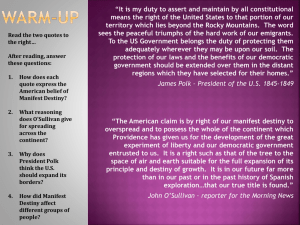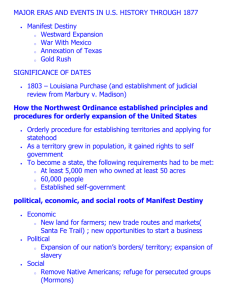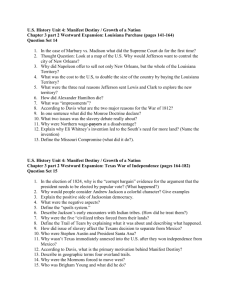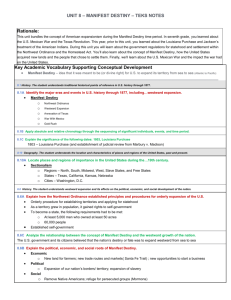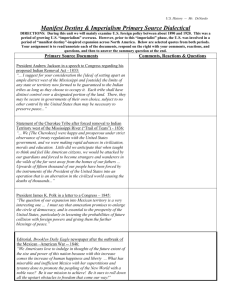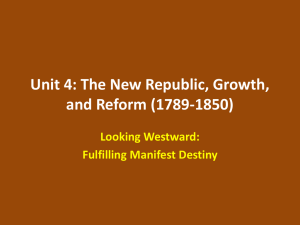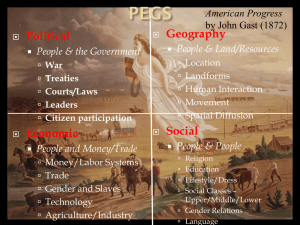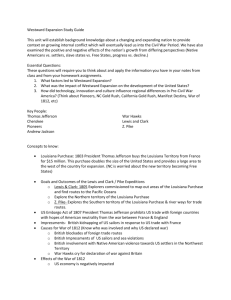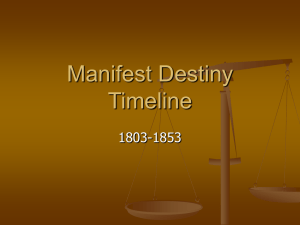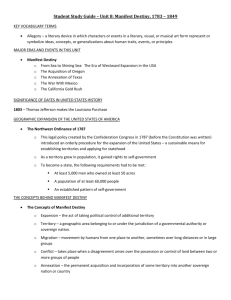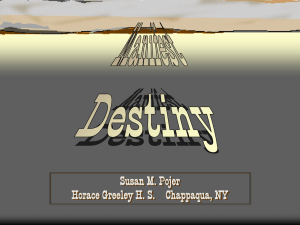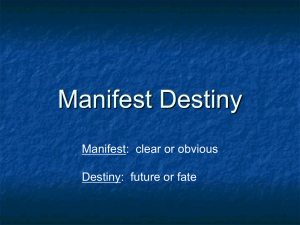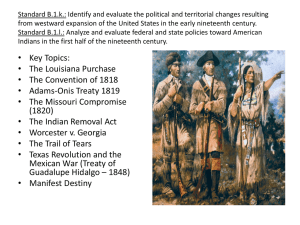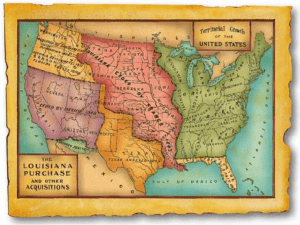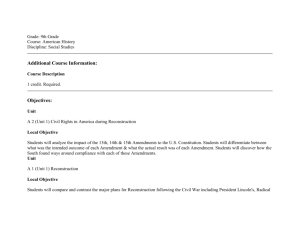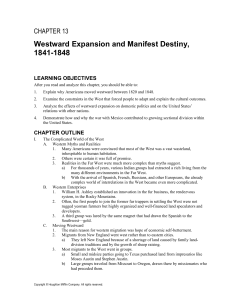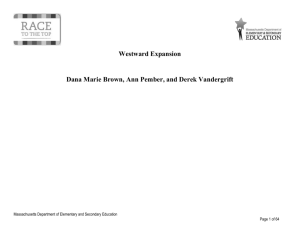UNIT 8 – MANIFEST DESTINY – TEKS NOTES Rationale: This unit
advertisement
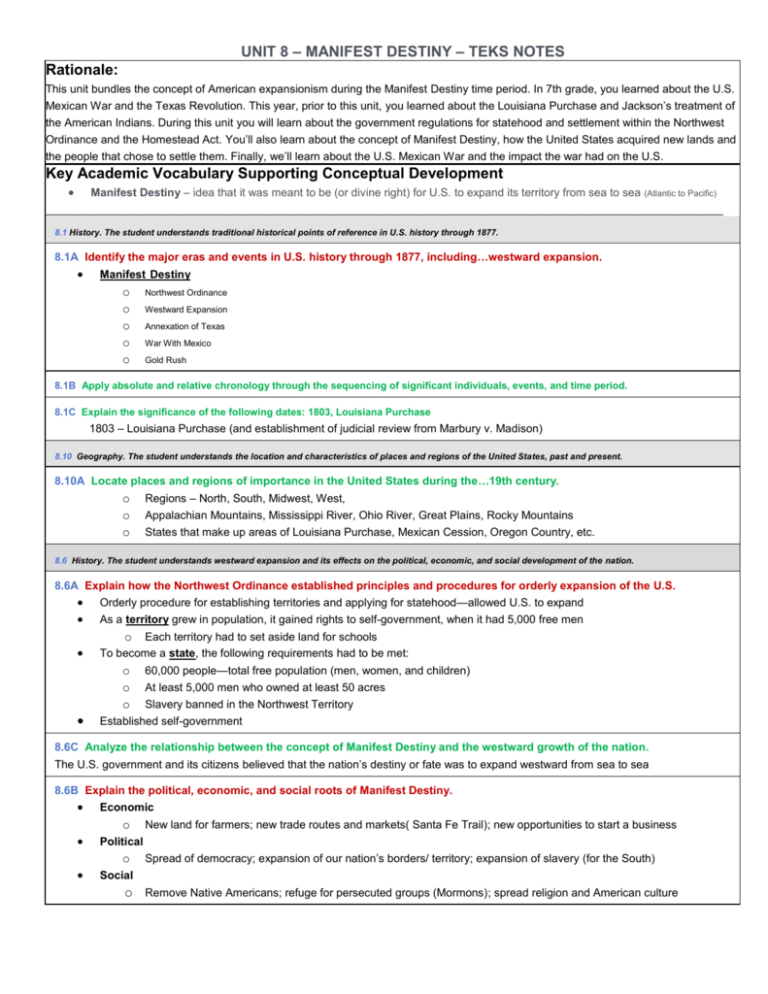
UNIT 8 – MANIFEST DESTINY – TEKS NOTES Rationale: This unit bundles the concept of American expansionism during the Manifest Destiny time period. In 7th grade, you learned about the U.S. Mexican War and the Texas Revolution. This year, prior to this unit, you learned about the Louisiana Purchase and Jackson’s treatment of the American Indians. During this unit you will learn about the government regulations for statehood and settlement within the Northwest Ordinance and the Homestead Act. You’ll also learn about the concept of Manifest Destiny, how the United States acquired new lands and the people that chose to settle them. Finally, we’ll learn about the U.S. Mexican War and the impact the war had on the U.S. Key Academic Vocabulary Supporting Conceptual Development Manifest Destiny – idea that it was meant to be (or divine right) for U.S. to expand its territory from sea to sea (Atlantic to Pacific) ____________________________________________________________________________________________________________ 8.1 History. The student understands traditional historical points of reference in U.S. history through 1877. 8.1A Identify the major eras and events in U.S. history through 1877, including…westward expansion. Manifest Destiny o o o o o Northwest Ordinance Westward Expansion Annexation of Texas War With Mexico Gold Rush 8.1B Apply absolute and relative chronology through the sequencing of significant individuals, events, and time period. 8.1C Explain the significance of the following dates: 1803, Louisiana Purchase 1803 – Louisiana Purchase (and establishment of judicial review from Marbury v. Madison) 8.10 Geography. The student understands the location and characteristics of places and regions of the United States, past and present. 8.10A Locate places and regions of importance in the United States during the…19th century. o o o Regions – North, South, Midwest, West, Appalachian Mountains, Mississippi River, Ohio River, Great Plains, Rocky Mountains States that make up areas of Louisiana Purchase, Mexican Cession, Oregon Country, etc. 8.6 History. The student understands westward expansion and its effects on the political, economic, and social development of the nation. 8.6A Explain how the Northwest Ordinance established principles and procedures for orderly expansion of the U.S. Orderly procedure for establishing territories and applying for statehood—allowed U.S. to expand As a territory grew in population, it gained rights to self-government, when it had 5,000 free men o Each territory had to set aside land for schools To become a state, the following requirements had to be met: o o o 60,000 people—total free population (men, women, and children) At least 5,000 men who owned at least 50 acres Slavery banned in the Northwest Territory Established self-government 8.6C Analyze the relationship between the concept of Manifest Destiny and the westward growth of the nation. The U.S. government and its citizens believed that the nation’s destiny or fate was to expand westward from sea to sea 8.6B Explain the political, economic, and social roots of Manifest Destiny. Economic o o New land for farmers; new trade routes and markets( Santa Fe Trail); new opportunities to start a business Political Spread of democracy; expansion of our nation’s borders/ territory; expansion of slavery (for the South) Social o Remove Native Americans; refuge for persecuted groups (Mormons); spread religion and American culture 8.6D Explain the causes and effects of the U.S.-Mexican War and their impact on the United States. Annexation of Texas by the U.S. angered Mexico U.S. and Mexico disagreed over the border between Texas and Mexico U.S.-Mexican War was viewed as a “War of Aggression” by many Americans. o Causes President Polk’s desire to expand the United States (Manifest Destiny) Border Dispute concerning southern boundary of Texas (Rio Grande was claimed by Texas and disputed by Mexico) Polk sent Gen. Zachary Taylor to build fort along the Rio Grande. Mexico attacked the fort. Mexico claimed the fort was an invasion of their territory. o U.S. claimed attack on fort was an act of war/aggression and that American blood had been spilled on American soil. Effects & Impact Treaty of Guadalupe Hidalgo (1848) ends the war, grants the United States the Mexican territory of New Mexico, Arizona, and California U.S. paid Mexico $10 million for Gadsden Purchase (1854) to help repay Mexico for annexation of Texas (1845) 8.6E Identify areas that were acquired to form the United States, including the Louisiana Purchase. Louisiana Territory Florida => Adams-Onis Treaty Texas Mexican Cession (New Mexico, Arizona, California, Utah, Nevada) Oregon Territory Gadsden Purchase 8.11A Analyze how physical characteristics of the environment influenced population distribution, settlement patterns, and economic activities in the United States during the…19th century. PHYSICAL CHARACTERISTICS OF THE ENVIRONMENT AND INFLUENCE ON POPULATION DISTRIBUTION, SETTLEMENT PATTERNS, AND ECONOMIC ACTIVITIES IN THE UNITED STATES DURING THE...19TH CENTURY Manifest Destiny o o o Gold in California – rush of settlers to California; pushed many American Indians off their lands; population of California quickly rises to the amount required for statehood California’s proximity to Pacific Ocean led to an increase of immigration from Asian nations. Rocky Mountains’ location between eastern and western parts of the United States; resulted in need for Gadsden Purchase to put in Southern railroad route for train transport of goods from East to West 8.23 Culture. The student understands the relationships between and among people from various groups, including racial, ethnic, and religious groups, during the 17th, 18th, and 19th c. 8.23D Analyze the contributions of people of various racial, ethnic, and religious groups to our national identity. CONTRIBUTIONS OF PEOPLE OF VARIOUS RACIAL, ETHNIC, AND RELIGIOUS GROUPS TO OUR NATIONAL IDENTITY o European immigrants—especially German and Irish contributed to growth of new and older cities in the East as o o well as new customs and traditions German: Christmas tree, “gymnasium”, “Kindergarten”, music programs, orchestras, baking, woodworking, etc. Irish: contributed greatly to building the Erie Canal and to building railroads in the East, public service (police, o political positions in cities) Hispanic/Mexican: culture from newly acquired Mexican Cession, included tradition of ranches, herding cattle, o cowboy culture; also previously had contributed to Texas’ independence Chinese: immigrants in California – contributed greatly to building of the Transcontinental Railroad from the West 8.26 Culture. The student understands the relationship between the arts and the times during which they were created. 8.26B Identify examples of American art, music, and literature that reflect society in different eras Manifest Destiny (Era: Westward Expansion) Art – "American Progress," by John Gast, 1872
